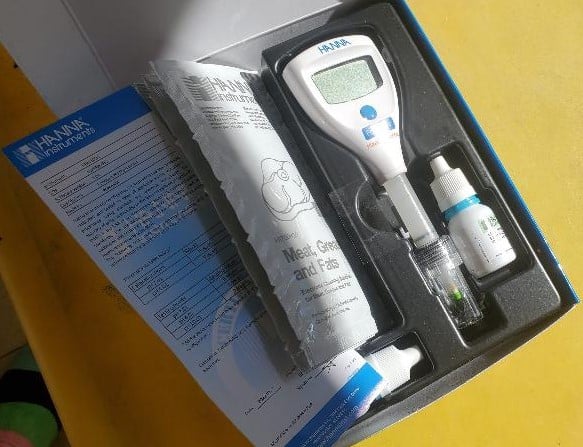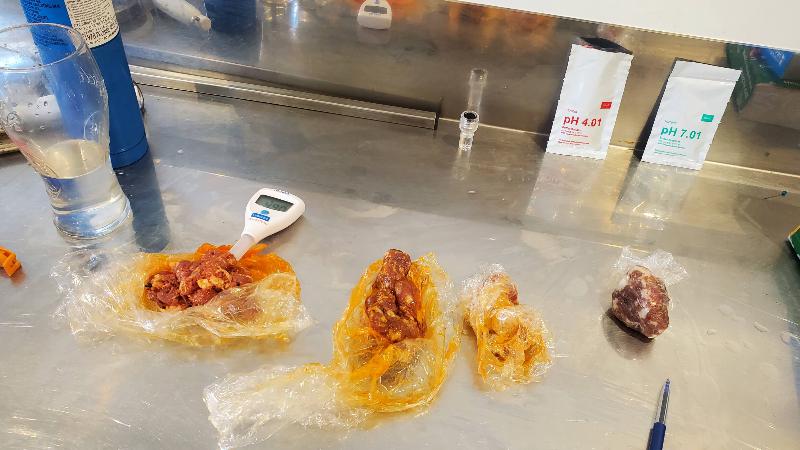For many years, I’ve been making salami without testing the pH or acidity during the initial fermentation stage. The pH Meter and acidity are very important aspects of dry-cured salami. Eventually, over the last few years, I’ve decided to be more consistent and thorough.
Though I’ve used starter cultures, either fast or slow action, I’ve been lucky to just about always have some wonderful results. Often, I use my senses, like smell and visual queues, to gauge the level of development from the fermentation stage using these starter cultures.
After we recently lined up a whole pig to butcher for traditional salumi and salami (many meats can be used for salami), I decided to help you help me get things more precise. After a lot of research and investigation – I’ll summarize the results of pH meters that I’ve looked at and evaluated.
The biggest hurdle was the rather sizeable investments for many brands of ph meters for salami. Then, I came across a ph meter that had the simplicity and accuracy I think could work for the wider community who come to this site, www.eatcuredmeat.com!
I will show you below the pH readings from the salamis we made. Two were fermented, two had no starter culture inoculation, and one was cold smoked.
For one of the salamis that did not have starter culture, I used Sangiovese red wine to see what effect this would have on pH (very interesting results).
ph Meter for Making Salami and Cured Meats at Home
To summarize my findings, here is my recommendation that will work for you.
If you are looking for a simple, cost-effective, and accurate ph meter or making salami at home. You should buy the Hanna Meat pH Tester.

What I Need To Test Salami

Accuracy of 0.01 ph Ideal
What I’ve discovered is you pay big bucks for a commercial ph Meter. Until recently, there wasn’t the accuracy needed in a cost-effective product ($60 USD).
In my opinion, one decimal place for pH testing is not accurate enough. Since we often try to get down to 5.3, a variation of + or—0.1 is rather significant. Many experienced salami makers will also say that the pH end reading will also significantly affect flavor.
Commercial ph Meter for Salami
I’ve researched pH meters for salami I make at home for about three years! It is very common to see $200 USD+ for some very nice technology.
Such as,
- Apera
- Hanna
- Milwaukee
It seems many are engineered for commercial purposes, as opposed to the home charcuterie.
If I were to pick on it, the Apera does have significant other measurements, such as temperature and moisture level, like the PH60S, but again, it is $200 USD+.
Around here at eatcuredmeat.com – I am not all about the cheapest options. However, if someone is going to use something possibly once or twice a year – you’re not going to go nuts in expenditure, I presume, unless you have bucket loads of cash.
Can I Use Litmus Paper for ph of Salami?
I wouldn’t, here is a link to a forum chat about the inaccuracy and inconsistent results they have had using litmus paper.
https://wedlinydomowe.pl/en/viewtopic.php?t=5165
After reading this and many other comments, it seems there is no way it can achieve the accuracy you need whilst making dry cured salami.
How do you Test pH for Salami
Using the calibration testing solutions for the Hanna Meat pH tester, I made sure I had accurate readings of 4.00 and 7.00. Once you have the accuracy, you take a small ‘sample’ of each salami mixture before fermenting.
You stick the (spearhead) probe into the salami ball. Then, record the results – I like to test every 6 hours, although this is a bit over the top.
Depending on the starter culture or even if you are not using one, 5.3 is the pH you often target as a minimum to get the acidity to a point where unwanted bacteria will struggle excessively.
Once the target pH has been achieved, the salami can move from ‘fermentation’ temperature and humidity to ‘drying’ conditions (often 50-50°F/10-15°C & 75-80% humidity).
Of course, these conditions aren’t essentially needed but will yield more consistent results! With all the effort it takes to make salami, it’s a crying shame not to have things work out! Trust me, I have many lessons!
I was recently at a local homemade Italian salami competition. I’m pretty sure there were 40 entries, all of which looked amazing. Nobody used pH testing, and for many intergenerational families that are producing amazing produce, they don’t (just a thought).
Also, making sure the salami (here is a link to the category on this site about salami) is in the fermentation environment for long enough can be crucial. Salami is often the challenging part!

Tom Mueller
For decades, immersed in studying, working, learning, and teaching the craft of meat curing, sharing the passion and showcasing the world of charcuterie and smoked meat. Read More
